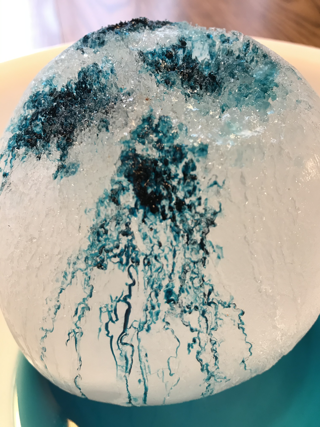Published April 29, 2020
Teaching Tuesdays: Ice Exploration
The Indiana State Museum and Historic Sites may be currently closed due to COVID-19 – but that doesn’t mean we can’t bring some of the museum to you!
On Tuesdays, we’re bringing families tons of educational content that’s easy for caregivers and their kids to do at home with materials you likely have on hand.
This week, we’re exploring ice!
Pure water forms a solid at 32 degrees Fahrenheit, or 0 degrees Celsius. When different chemicals are added to water, the freezing point can change.
In this exercise, see what effect certain household ingredients have on ice.
MATERIALS

- Ice (you can use regular cubed ice, or for a longer investigation, try freezing blocks of ice or filling a water balloon with water and freezing. These will take about two days to freeze solid.)
These are suggested items to use in your investigation:
- Salt
- Sugar
- Baking Soda
- Small containers for the salt/sugar/baking soda
- Food coloring
- Popsicle stick
- Tray or bowl
- Flashlight
- Cup of water
- String
INSTRUCTIONS
1. Prep your materials. Place the ice in a tray or bowl, and prep the salt, sugar, baking soda and any other powders to test by putting about ¼ cup of each into separate containers.
2. Observe the ice and think about what questions you have.
3. Have your child determine what questions they want to investigate. Encourage them to focus on questions they can test with the materials on hand.
4. Let your child’s questions guide the experiment. For example, if they wonder how long it will take to melt a half cup of water, follow their lead and see how long it takes.
5. Next, explore with the materials. Some ideas to try:
- See what happens when you sprinkle salt over the top vs. just placing a mound of salt on top.
- See if sugar and salt have similar or different effects on the ice.
- Sprinkle baking soda on the ice to see what happens.
- Shine a light through the ice ball to see how far the light travels.
BONUS
Add a few drops of food coloring on top of the ice to better see the trails left as the ice melts.

TIPS FOR PARENTS
During and after the activity, ask your child:
- What did you observe?
- What happened when you added different materials?
- What would happen if you added more or less of one thing? What about if you added the material in a different way?
- If you had to melt snow on your sidewalk, what method would work best? How do you know?









